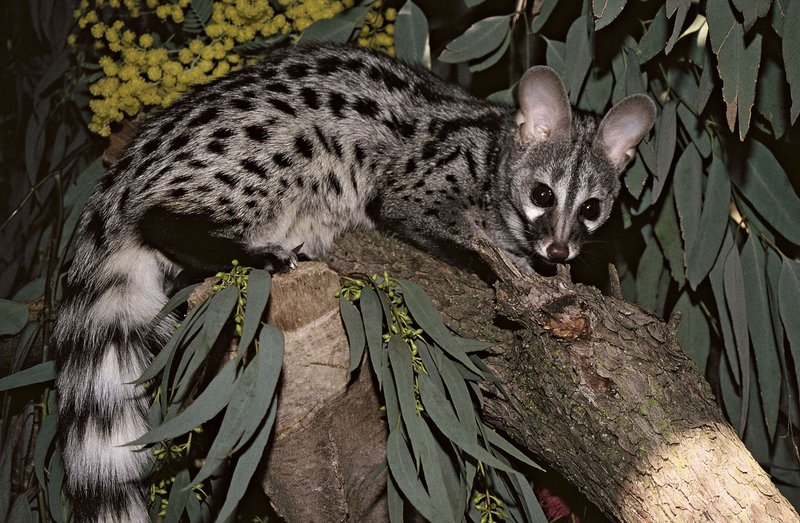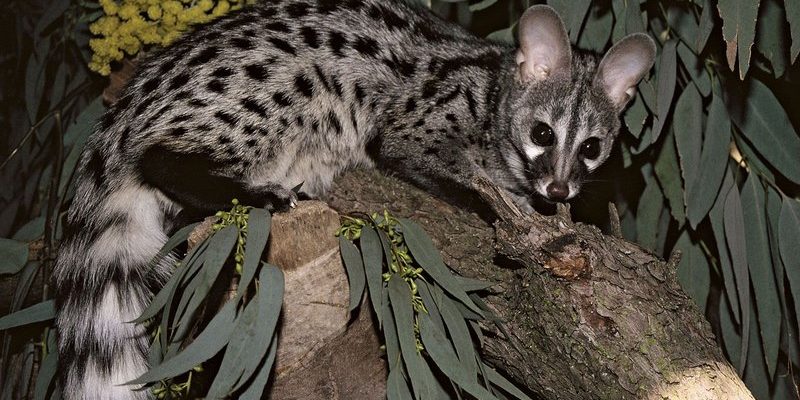
Imagine you’re at a wildlife park or flipping through a nature magazine, and you see a variety of animals with similar markings and shapes. It’s a bit like spotting look-alikes in a crowd; one tiny detail can help you figure out who’s who. Just like identifying friends at a party, knowing the differences can deepen your appreciation for these creatures. So, let’s dive in and explore ten animals that might remind you of the genet, along with handy tips on how to tell them apart.
1. Civet
Civets are often the first animals that come to mind when thinking of genets. With their long bodies and patterned coats, they have a lot in common with their spotted cousins. Civets have a more rounded face and a bushier tail compared to genets. You might notice the civet’s distinctive markings, which can range from stripes to spots, depending on the species.
What sets civets apart is their behavior. They’re nocturnal and tend to be more secretive than genets, often hiding in trees. If you catch one in action, it might be foraging for fruit, insects, or small animals. So, if you see a critter with a similar size and shape but more of a shy demeanor, it’s probably a civet.
2. Ocelot
Next up is the ocelot, a smaller wild cat known for its beautiful fur pattern. Ocelots have larger eyes and a more pronounced facial structure than genets. While both animals have spots, ocelots possess a distinct “marbled” coat that catches the eye. Think of them as the fancy dressers of the feline world.
You might be wondering how to spot one in the wild. Unlike genets, which are often found in Africa, ocelots roam the jungles and grasslands of South America. If you’re on a wildlife safari and see a robust cat with bold markings, you could be lucky enough to see an ocelot!
3. African Wildcat
The African wildcat is another cousin worth mentioning. These cats are slightly smaller than your average domesticated cat and have a similar build to genets, with long legs and a slender body. Although they lack the distinctive markings of a genet, their coloration can sometimes be quite similar.
If you’re trying to tell them apart, focus on facial features. Wildcats have a narrower face and more pointed ears. Plus, while genets climb well, African wildcats are more grounded, preferring to hunt on the ground rather than in trees.
4. Margay
The margay is a small wild cat that’s often confused with ocelots and even genets due to its similar size and spotted coat. Margays have incredibly flexible leg joints, which allow them to climb trees with astounding agility—something genets are also known for.
However, margays have distinct markings that are more closely aligned to “bands” than “spots.” If you see a cat-like animal moving gracefully through the branches of a tree, you may just be watching a margay in action.
5. Serval
Now, let’s talk about the serval. This African cat has long legs and ears, making it look quite different from the flat, elongated body of a genet. While both animals have spots, servals are recognizably taller and larger, standing out in the grasslands.
You might find it interesting that servals are expert hunters, capable of leaping high to catch birds. If you see a taller creature with a long neck and big ears peeking out above the grass, it’s likely a serval and not a genet.
6. Spotted Hyena
Hyenas might seem like an unusual comparison, but the spotted hyena shares similar spot patterns with the genet. Hyenas have a more muscular build, however, which distinguishes them from the slender genet. Plus, their facial structure is more robust, with a characteristic stronger jaw.
When it comes to behavior, hyenas are social animals, often living in groups called clans. If you hear a hearty laugh echoing across the African savanna, you’ve likely stumbled upon a group of spotted hyenas having a good time.
7. Kinkajou
Let’s switch gears and look at the kinkajou—a small, nocturnal mammal found in Central and South America. While not exactly similar in appearance, they both have long, flexible bodies and play a role in their ecosystems. Kinkajous have a curled tail that they use for balance when climbing, unlike the more traditional tail of a genet.
If you catch a glimpse of one, you might notice its big, round eyes and golden-brown fur. Their playful, curious nature makes them fun to watch. If you see something small and endearing swinging from the treetops, it could be a kinkajou rather than a genet.
8. Tarsier
How about the tarsier? These tiny primates may not look like genets at first glance, but they share a common trait: big eyes! Tarsiers have exceptionally large eyes that are perfect for their nocturnal lifestyle. Much smaller than genets, they have a squat body and long fingers, which help them navigate their forest home.
If you’re in Southeast Asia and notice a small creature with huge eyes peering at you from a tree branch, it’s probably a tarsier. While they won’t resemble genets in size, their similar nocturnal habits make them a fun comparison!
9. Quoll
Moving to Australia, we meet the quoll. These small marsupials bear some similarities to genets in terms of size and coat pattern. Quolls come in different varieties, and they might remind you of genets with their spotted bodies.
However, what sets them apart is their broader snout and different ear shape. Quolls are more robust and often have a more grizzled appearance. If you get a chance to see one among the Australian fauna, you’ll notice they have a different vibe from the sleek, graceful movement of a genet.
10. Fossa
Lastly, let’s not forget about the fossa, the largest carnivorous mammal in Madagascar. With a body shape that resembles a mix between a weasel and a cat, fossas are often mistaken for genets. They’ve got long limbs and a thin tail, but their face is more pronounced and cat-like.
Fossas are agile climbers and are known for their hunting skills. If you see a creature darting around in the trees of Madagascar with a more pronounced snout and larger stature, it’s likely a fossa.
In the grand tapestry of nature, genets and their look-alikes each have a story to tell. From the graceful margay to the playful kinkajou, these animals share traits that can leave us guessing. The next time you find yourself pondering the differences between these fascinating creatures, remember to look closely at their features, behavior, and habitats.
Understanding these differences not only enhances your knowledge but also fosters a deeper appreciation for wildlife. So, whether you’re a budding naturalist or just enjoying some animal facts, I hope this guide helps you recognize the unique family of creatures that share the spotlight with the incredible genet!

